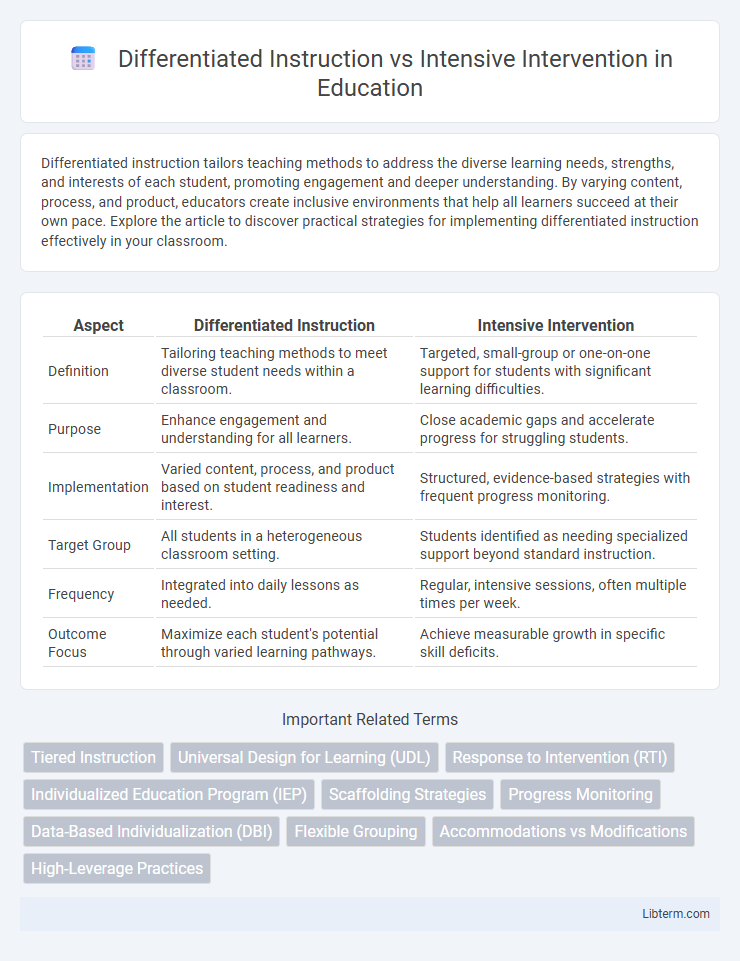Differentiated instruction tailors teaching methods to address the diverse learning needs, strengths, and interests of each student, promoting engagement and deeper understanding. By varying content, process, and product, educators create inclusive environments that help all learners succeed at their own pace. Explore the article to discover practical strategies for implementing differentiated instruction effectively in your classroom.
Table of Comparison
| Aspect | Differentiated Instruction | Intensive Intervention |
|---|---|---|
| Definition | Tailoring teaching methods to meet diverse student needs within a classroom. | Targeted, small-group or one-on-one support for students with significant learning difficulties. |
| Purpose | Enhance engagement and understanding for all learners. | Close academic gaps and accelerate progress for struggling students. |
| Implementation | Varied content, process, and product based on student readiness and interest. | Structured, evidence-based strategies with frequent progress monitoring. |
| Target Group | All students in a heterogeneous classroom setting. | Students identified as needing specialized support beyond standard instruction. |
| Frequency | Integrated into daily lessons as needed. | Regular, intensive sessions, often multiple times per week. |
| Outcome Focus | Maximize each student's potential through varied learning pathways. | Achieve measurable growth in specific skill deficits. |
Understanding Differentiated Instruction
Understanding differentiated instruction involves tailoring teaching methods, materials, and assessments to meet diverse student needs within a general classroom setting. This approach emphasizes flexible grouping, varied content delivery, and personalized learning paths based on students' readiness, interests, and learning profiles. Differentiated instruction contrasts with intensive intervention, which provides targeted, intensive support for students with significant learning difficulties.
Defining Intensive Intervention
Intensive intervention refers to highly individualized instructional strategies designed to address significant learning gaps through targeted support, frequent progress monitoring, and adjusted instructional intensity. It is often implemented for students who do not respond adequately to differentiated instruction or standard interventions, emphasizing smaller group sizes or one-on-one teaching. This approach involves specialized resources and evidence-based methods tailored to remediate specific academic or behavioral challenges.
Key Principles of Differentiated Instruction
Differentiated Instruction centers on tailoring teaching methods, content, and assessment to address diverse student learning styles, readiness levels, and interests within the same classroom environment. It emphasizes flexible grouping, ongoing assessment, and adaptive lesson planning to promote engagement and mastery for all learners. This approach contrasts with Intensive Intervention, which provides targeted, often one-on-one support for students with significant learning difficulties.
Core Components of Intensive Intervention
Intensive intervention in education centers on targeted, data-driven instruction tailored to students demonstrating significant academic or behavioral challenges, emphasizing explicit teaching, frequent progress monitoring, and increased instructional intensity. Core components include personalized goal-setting, frequent one-on-one or small group instruction, and continuous data analysis to adjust teaching strategies promptly. Differentiated instruction, by contrast, adapts general classroom teaching methods to varied learner needs but lacks the systematic intensity and frequent data-based adjustments inherent in intensive intervention.
Target Student Populations
Differentiated instruction primarily targets diverse learners within general education classrooms, including students with varying readiness levels, interests, and learning profiles. Intensive intervention focuses on students with significant learning gaps or disabilities requiring specialized, research-based strategies beyond standard differentiation. Both approaches aim to personalize learning but differ in intensity and specificity of support based on student needs.
Classroom Implementation Strategies
Differentiated instruction tailors teaching methods and materials to meet diverse student needs within a standard classroom setting by varying content, process, and products based on learner profiles. Intensive intervention targets students with significant learning gaps through specialized, explicit instruction often delivered in small groups or one-on-one, focusing on skill deficits using progress monitoring tools. Effective classroom implementation merges both approaches by integrating flexible grouping, formative assessments, and targeted support to maximize individual student growth.
Data-Driven Decision Making
Differentiated instruction leverages formative assessment data to tailor teaching strategies that meet diverse student needs within heterogeneous classrooms. Intensive intervention relies on progress monitoring and valid, reliable data to design targeted, individualized supports for students with significant learning gaps. Both approaches prioritize data-driven decision making to optimize educational outcomes through continuous analysis and adjustment of instructional practices.
Measuring Effectiveness and Outcomes
Measuring effectiveness in differentiated instruction involves tracking student progress through formative assessments tailored to diverse learning styles and abilities, ensuring personalized growth. Intensive intervention effectiveness is evaluated by standardized measures indicating significant improvement in specific skill gaps, often using progress monitoring tools to adjust instructional intensity. Comparing outcomes, differentiated instruction aims for broad academic engagement, while intensive intervention targets foundational skill mastery for struggling learners.
Challenges and Solutions in Each Approach
Differentiated instruction faces challenges such as addressing diverse learning styles and pacing within a single classroom, often requiring significant teacher preparation time and resources. Solutions include incorporating flexible grouping, utilizing technology for personalized learning, and ongoing professional development to enhance adaptive teaching strategies. Intensive intervention struggles with limited instructional time and resource constraints for students needing intensive support, which can be mitigated by data-driven progress monitoring and targeted, evidence-based instructional techniques.
Integrating Differentiated Instruction with Intensive Intervention
Integrating differentiated instruction with intensive intervention enhances personalized learning by tailoring teaching strategies to diverse student needs while addressing specific skill gaps through targeted support. This combined approach allows educators to modify content, process, and product based on individual readiness and learning profiles, ensuring both broad accessibility and focused remediation. Data-driven assessment guides the seamless alignment of differentiated instruction's flexibility with the precision of intensive intervention, maximizing student growth and academic achievement.
Differentiated Instruction Infographic

 libterm.com
libterm.com